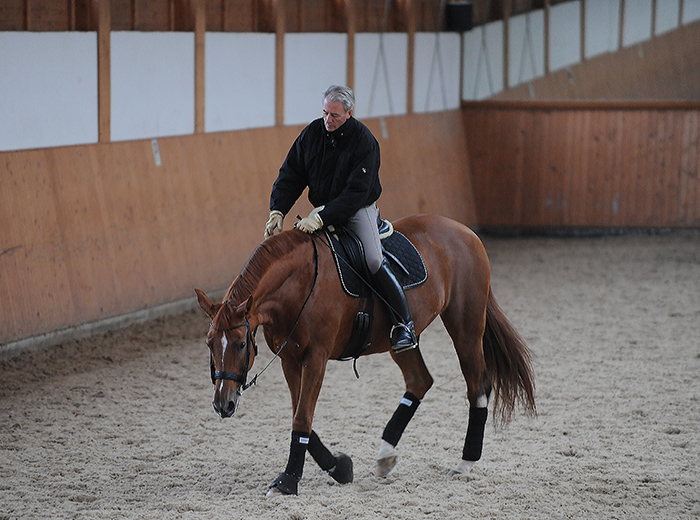
Story – Chris Hector & Photos – Roz Neave
Jean Bemelmans is one of Germany’s most successful trainers of Grand Prix horses. Under his watchful eye, the Spanish team became one of the world’s top dressage nations, and Jean has gone on to work with the French team. He has recently formed a partnership with CB Dressage an exciting team of up-coming stars who bring together experience from both Germany and Spain. The team also now includes Australian, Ashlea Day who has spent several years working and gaining experience in Germany.
Jean Bemelmans obviously enjoys his time in the saddle, and he takes delight in his ride on a beautiful nine-year-old Russian mare. When we see them work, it is just Jean’s fifth ride on the horse, but she shows so much potential, and has that ‘look at me’ starry quality.
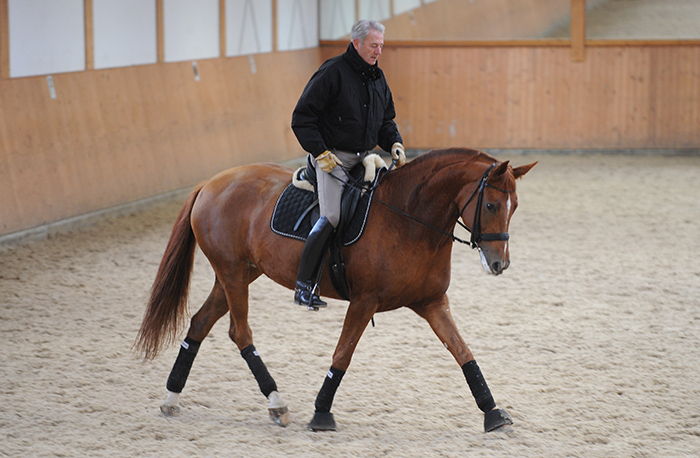
Jean and his Russian mare
Jean knows she can do better:
“She can do all the Grand Prix exercises, but she is not over her back, she is still not swinging enough, she is a little bit tight. It is a beautiful mare, it is a clever mare.
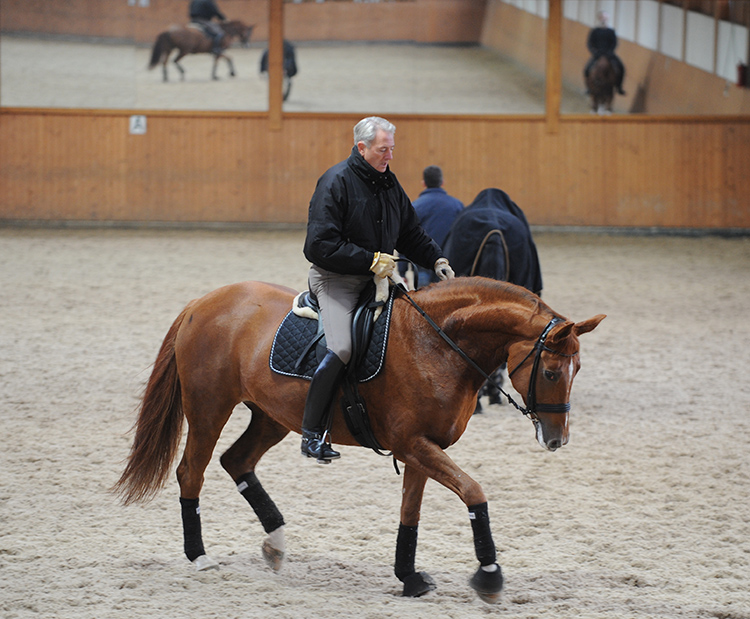
The walk is a little short, but all the other things, canter, piaffe, passage, are very good. You feel that the body is not loose. I like her, and she is nice to look at. She comes from Russia. She did a Grand Prix there with 61%, not very much but I think if I can improve more body control, because for me it is all about body control – coming, going, up, left, right, this is dressage.
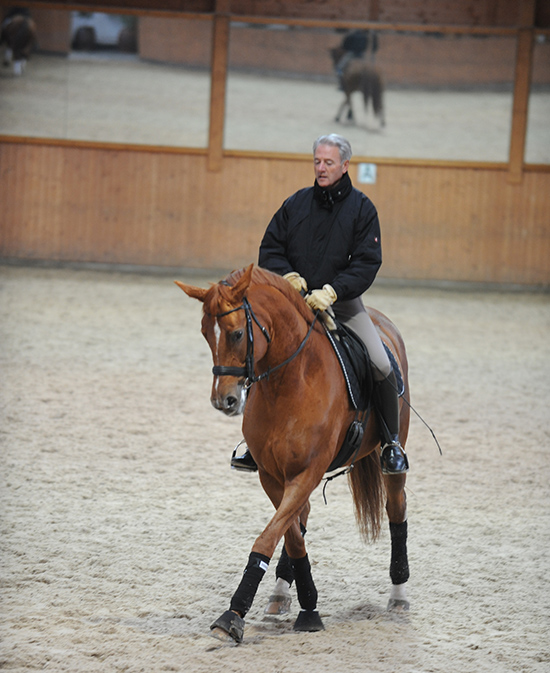
I see some people they ride dressage and the put the horse in a position and they have to be one hour in that position, and they do exercises, exercises, exercises, and you think, oh this poor horse cannot be happy with this.”
“If you see my little black one, he does it nice like I did today, and then you give him the long rein, and whoosh, you see the fun he has. He shakes his head, okay, now I am done.”
more on training better horses follows
Jean feels that riders and trainers have far greater opportunities with the modern performance horse, but these wonderful horses still have to be trained:
“Now they are breeding better and better horses, and these horses are in better balance but at the end the submission is the most important thing. It comes down to the stop and go, and if the stop and go is very good, then horses get supple.
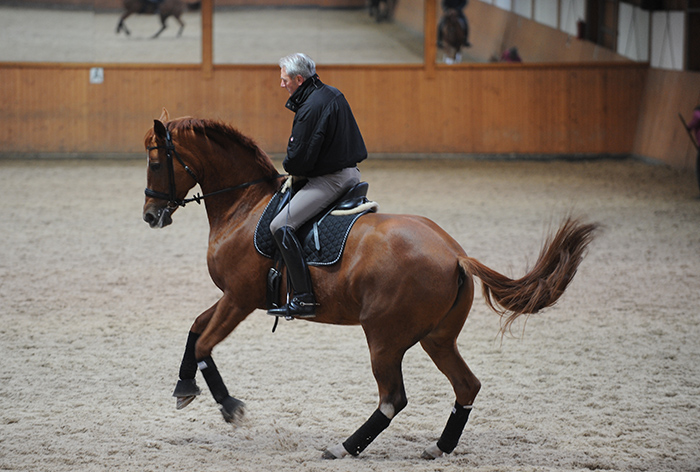
Some horses have a better balance, some horses you have to work on it, and with the transitions, you get the balance. If they are not in balance, they fall on the forehand, but when you see a really top Grand Prix horse, if you see a nice performance, this is in balance, and to get that balance you have to do a thousand transitions to get them soft, they have to wait, so you can decide – now I go, then you come back… and for this you need a very good balanced seat.”
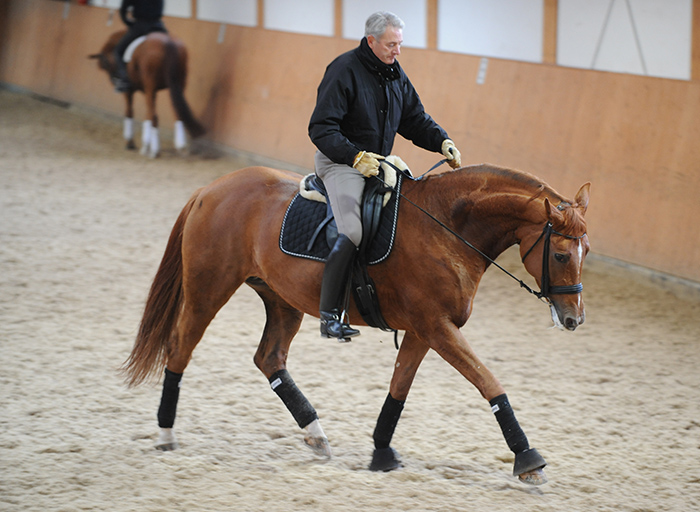
“You see many riders nowadays they start too early riding, and they have not prepared their own body to work with the body of the horse. You have to have your body loose so you can be with the rhythm of the horse, to be flexible and follow him. For example, if you jump a little fence and every time you are over the fence, you hit the horse in the mouth – the first time the horse says, oh what is this? The second time, he will put his head up, after three or four times, he will not jump any more because the rider is not in balance and takes the horse out of balance. This is where a good jumping rider always gives the horse enough freedom to jump. If you have body control then your horse can be happy under you…”
“Dressage is the same. You see many riders, and if they cannot sit well, they hang on the rein and how can their horse develop balance?”
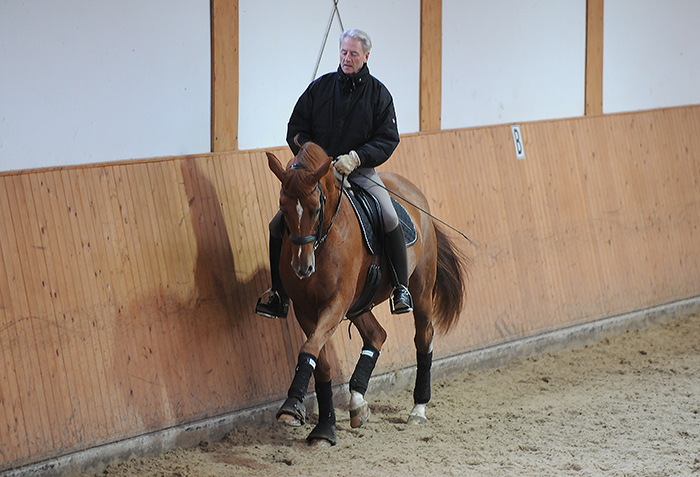
As so often happens, the conversation turns to lightness, and contact:
“Lightness sounds very good, if it is light, but it is better if it is not too light because a horse that is too light in the hand is more difficult to ride than a horse that is a little bit heavy on the hand. Okay we always have to talk about finding the right balance, but in the end, contact is nothing more than the contact to the hind leg, the contact that the rider makes between the mouth and the hind leg. This is the duty of the rider, to put these two together. The moment the horse starts to move, and he moves behind, you have to feel it in your hand, then you have to let it out.”
More on contact follows…
“Contact has to be just that, contact. People think ‘oh this horse is very light I have nothing in my hand’ – this is wrong because then you have no contact to his hind legs.”
One of Jean’s endearing qualities is his openness to new ideas, and he is quite happy to pay tribute to some of the techniques of the ubiquitous Pat Parrelli, although as Jean explains, he doesn’t really have time to do a lot of rope twirling:
“I personally do not have too much time. I would love to do more with the horses, not just the riding, but in the end, the day has only 24 hours and you have so many things to do. It is not only Pat Parrelli, we have to think back to where everything starts, and if I think a little bit about myself, I came out of the countryside, so I was living on a farm. On the farm you live with the animals and you see how they live to together. If you see the control in a herd, if you see stallions and mares, there is super control there. These little fights they have from time to time, they clear it, and once it is clear, it is okay. If you see how fine a horse looks at another horse, and it is only the look to tell the other one, what this one wants. I always try not to lose this sense because sometimes with the riding you are thinking about marks and competitions, and you lose this fine sense, and I think people like Pat Parelli they have this sense to work with the horses.”
“For example if you were brought up in a town and you are not used to animals, you can be scared of a dog, but if you live in the country you are not scared, the dog knows and respects you, you don’t have to speak to him, it’s the antenna. If I am riding, I am concentrated. Some people they ride and they can talk or look left or right, the moment I start to ride I can concentrated on my horse.”
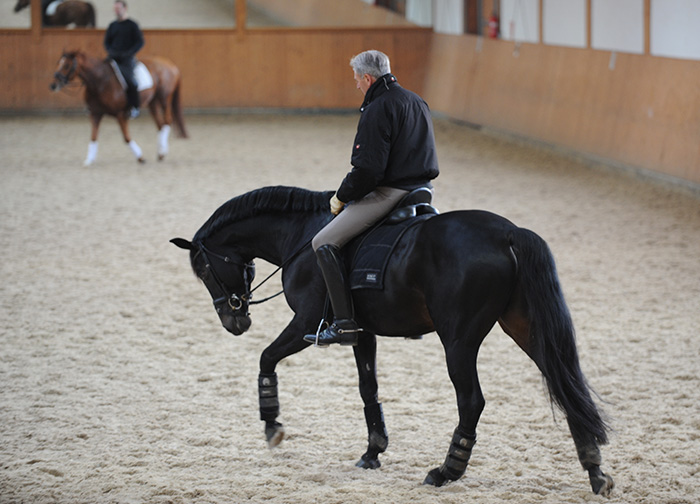
Again and again it comes down to obedience:
“Every horse has enough power inside. It comes from the obedience, coming and going, stop and go, stop and go. With this stop and go you develop control – you have enough power, you just have to control it.”
“If you saw the black stallion I was riding before, you can see that I can make his trot change by changing my body. I sit in another position, and he moves in another way. I let my body go a little bit and he also lets his body go a little bit out. Then I push my body again a little bit, and he starts also, and this is what I mean about body control with submission, and then the power comes. If you cannot do this, then you cannot have power. You can be quick, you can go left, you can go right but you don’t have power. Power is something that comes from behind and is controlled.”
Can we talk a little about positive tension… there is a lot of argument in the dressage scene about horses looking stressed in the Grand Prix, how do we find the line between good tension and bad tension?
“This is one of the biggest discussion points, especially in the Grand Prix, because you can do a Prix St Georges without tension. You just can do simple exercises, but you cannot do Passage / Piaffe if there is not a positive tension in the horse. You need this, and at the end a good judge, and a good rider, know how to manage this tension because it can go into negative tension, or it can just become weak – nothing. You could see it with David when he went to ride a collected trot, but it was not collected, it was just slow. But when he took the little whip and you could see that the horse developed some positive tension. At the end it is not something that you can measure, you have to see it, and I think a good judge and a good rider, they feel, they know the borders. If you go car racing and if you don’t go full speed into the corner, then you cannot win, but if you go too quick, you fly out of the corner. It is all a question of balance – balance is a very important word in what we are doing. Not just for riding, but with all our life, it is a question of balance.”
http://www.horsemagazine.com/thm/2018/01/dressage-jean-bemelmans-modern-master/
Top proven bloodlines and available in Australia from International Horse Breeders – for more go to: www.ihb.com.au
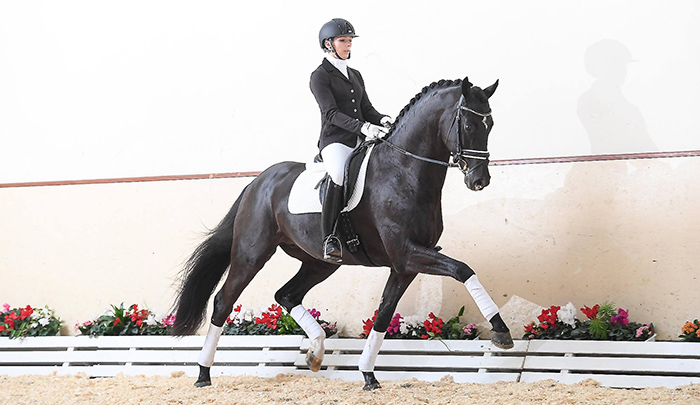
Zenon
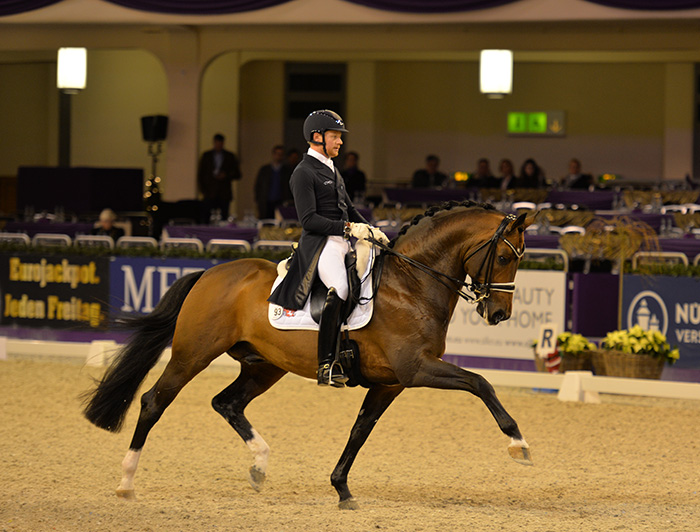
Foundation


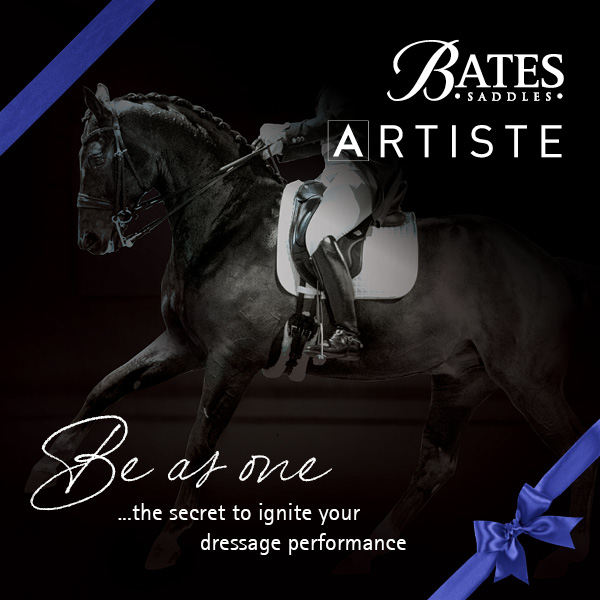
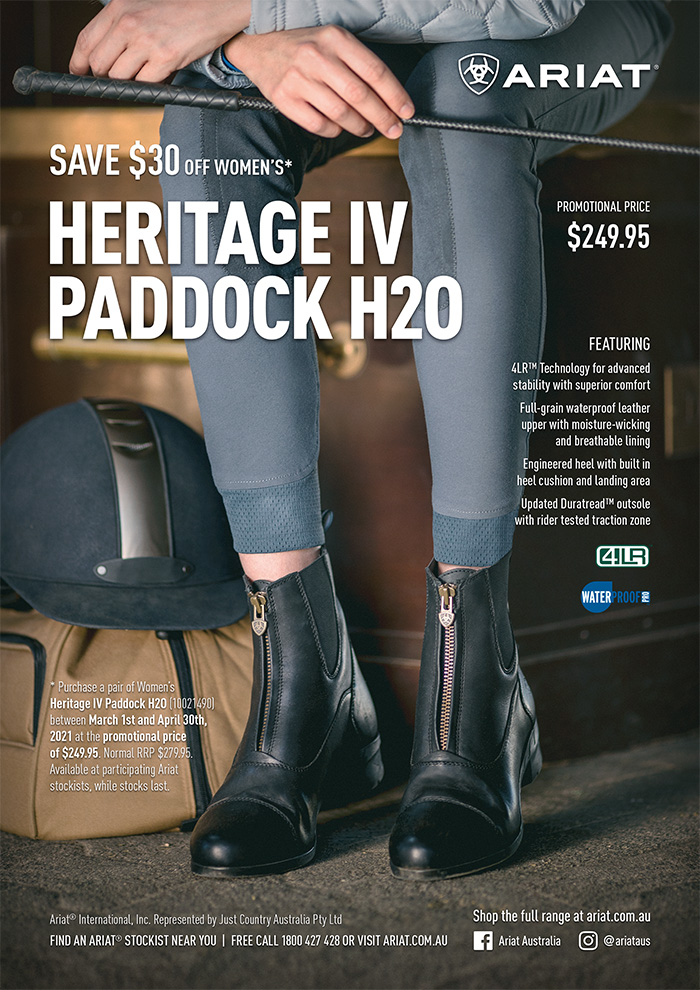
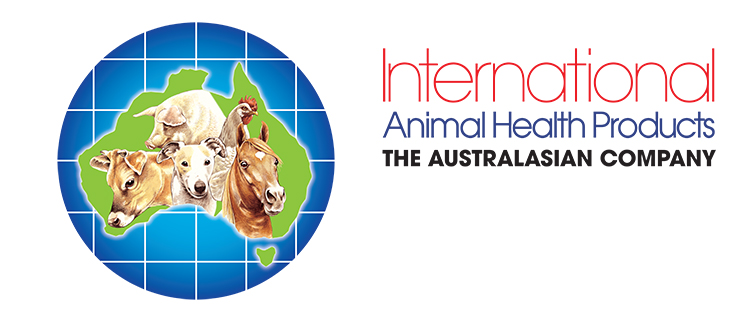
Thoroughly enjoyed reading this article, you talk a lot of sense! Thankyou
Love this man always comes across as a real gentleman
Strive for Positive Balance & Schwang! Life is GOOD!